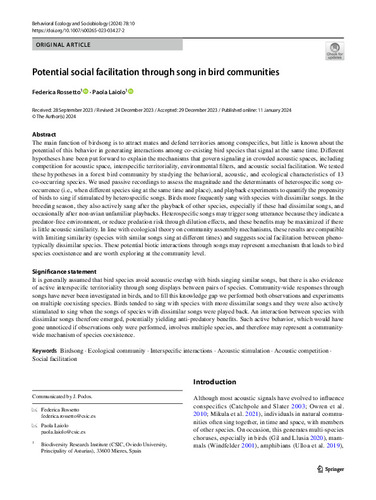Potential social facilitation through song in bird communities
Autor(es) y otros:
Fecha de publicación:
Versión del editor:
Citación:
Resumen:
The main function of birdsong is to attract mates and defend territories among conspecifcs, but little is known about the potential of this behavior in generating interactions among co-existing bird species that signal at the same time. Diferent hypotheses have been put forward to explain the mechanisms that govern signaling in crowded acoustic spaces, including competition for acoustic space, interspecifc territoriality, environmental flters, and acoustic social facilitation. We tested these hypotheses in a forest bird community by studying the behavioral, acoustic, and ecological characteristics of 13 co-occurring species. We used passive recordings to assess the magnitude and the determinants of heterospecifc song cooccurrence (i.e., when diferent species sing at the same time and place), and playback experiments to quantify the propensity of birds to sing if stimulated by heterospecifc songs. Birds more frequently sang with species with dissimilar songs. In the breeding season, they also actively sang after the playback of other species, especially if these had dissimilar songs, and occasionally after non-avian unfamiliar playbacks. Heterospecifc songs may trigger song utterance because they indicate a predator-free environment, or reduce predation risk through dilution efects, and these benefts may be maximized if there is little acoustic similarity. In line with ecological theory on community assembly mechanisms, these results are compatible with limiting similarity (species with similar songs sing at diferent times) and suggests social facilitation between phenotypically dissimilar species. These potential biotic interactions through songs may represent a mechanism that leads to bird species coexistence and are worth exploring at the community level.
The main function of birdsong is to attract mates and defend territories among conspecifcs, but little is known about the potential of this behavior in generating interactions among co-existing bird species that signal at the same time. Diferent hypotheses have been put forward to explain the mechanisms that govern signaling in crowded acoustic spaces, including competition for acoustic space, interspecifc territoriality, environmental flters, and acoustic social facilitation. We tested these hypotheses in a forest bird community by studying the behavioral, acoustic, and ecological characteristics of 13 co-occurring species. We used passive recordings to assess the magnitude and the determinants of heterospecifc song cooccurrence (i.e., when diferent species sing at the same time and place), and playback experiments to quantify the propensity of birds to sing if stimulated by heterospecifc songs. Birds more frequently sang with species with dissimilar songs. In the breeding season, they also actively sang after the playback of other species, especially if these had dissimilar songs, and occasionally after non-avian unfamiliar playbacks. Heterospecifc songs may trigger song utterance because they indicate a predator-free environment, or reduce predation risk through dilution efects, and these benefts may be maximized if there is little acoustic similarity. In line with ecological theory on community assembly mechanisms, these results are compatible with limiting similarity (species with similar songs sing at diferent times) and suggests social facilitation between phenotypically dissimilar species. These potential biotic interactions through songs may represent a mechanism that leads to bird species coexistence and are worth exploring at the community level.
ISSN:
Patrocinado por:
Open Access funding provided thanks to the CRUE-CSIC agreement with Springer Nature. This work was supported by the Spanish Ministry of Science and Innovation (grant numbers CGL2017-85191-P, PID2020-115259CB-100, PRE2018-086304) and by FICYT (grant IDI/2021/000075).
Open Access funding provided thanks to the CRUE-CSIC agreement with Springer Nature. This work was supported by the Spanish Ministry of Science and Innovation (grant numbers CGL2017- 85191-P, PID2020-115259CB-100, PRE2018-086304) and by FICYT (grant IDI/2021/000075).
Colecciones
- Artículos [37530]
- Biología de Organismos y Sistemas [761]
- Investigaciones y Documentos OpenAIRE [8294]
Ficheros en el ítem





